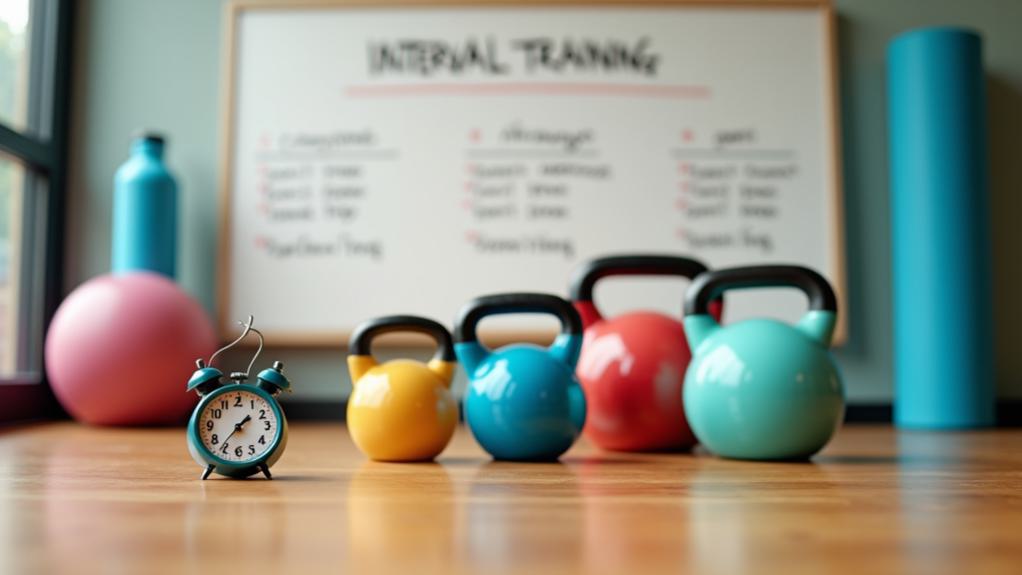To incorporate interval training into your routine, start by setting aside 10-30 minutes for a workout. Begin with a warm-up, then alternate between high-intensity bursts (like sprinting or fast cycling) for 20-60 seconds, followed by 1-2 minutes of moderate recovery. Aim for this 2-3 times a week, gradually increasing the intensity as you build endurance. Track your progress to stay motivated and adjust intervals as needed. Remember, it’s all about pushing yourself while allowing recovery to keep it effective. Stick around to discover more about structuring and advancing your interval workouts for even better results!
Key Takeaways
- Start with a proper warm-up of 5-10 minutes before beginning high-intensity intervals to prepare your body.
- Begin with 20-30 seconds of high-intensity exercise followed by 40-60 seconds of active recovery.
- Incorporate interval training 1-3 times per week, allowing for rest days in between sessions.
- Gradually increase the intensity and reduce recovery times as your fitness level improves.
- Track your progress by recording interval durations and heart rate to monitor improvements over time.
Understanding Interval Training
Interval training is like a rollercoaster ride for your fitness routine, taking you through exhilarating peaks of intense effort followed by rejuvenating lows of recovery. This training method alternates between high-intensity work intervals and moderate-intensity recovery intervals, effectively boosting both your cardiovascular system and muscular endurance.
You can apply interval training to various activities, whether you prefer running, swimming, or cycling. A typical session might start with a warm-up, followed by rounds of intense effort—like sprinting for two minutes—interspersed with recovery periods, such as jogging for four minutes. This structure not only keeps your workouts engaging but also promotes significant improvements in your cardiovascular capacity (Vo2 max), more effectively than steady-state exercises.
Most coaches suggest incorporating high-intensity interval training into your routine one to three times per week. Just remember to pay attention to recovery intervals; they’re essential for preventing injury and avoiding overtraining.
Benefits of Interval Training
When you embrace interval training, you’re not just boosting your cardiovascular health; you’re also maximizing your workout efficiency.
This method allows you to achieve incredible fitness gains in a fraction of the time compared to steady-state workouts.
Cardiovascular Health Boost
Incorporating interval training into your routine can be a simple yet effective way to boost your cardiovascular health, as highlighted in Health and Wellness for Women in Midlife.’ By engaging in high-intensity interval training (HIIT), you can enhance your heart’s efficiency, reduce your resting heart rate, and improve your overall fitness. Studies show that HIIT can elevate cardiorespiratory fitness by 17% more than traditional steady-state workouts.
Here’s a quick overview of the benefits:
| Benefit | Description |
|---|---|
| Heart Efficiency | Improves stroke volume and reduces resting heart rate. |
| Increased Heart Rate Variability | Promotes better recovery and lowers heart disease risk. |
| Afterburn Effect | Elevates metabolism, leading to more calories burned post-exercise. |
| Reduced Chronic Disease Risk | Linked to lower chances of hypertension and type 2 diabetes. |
Time-Efficient Workouts
Finding time to work out can be challenging, but incorporating interval training into your routine offers a smart solution. HIIT workouts are time-efficient, combining short bursts of high-intensity exercise with recovery periods. This approach allows you to achieve significant fitness gains in as little as 10 to 30 minutes, making it perfect for your busy schedule.
Research shows that high-intensity interval training can yield cardiovascular improvements and fat loss results comparable to longer, moderate-intensity sessions. So, you don’t have to spend hours in the gym to see results.
Plus, the afterburn effect from interval training continues to burn calories even after your workout, maximizing your total caloric expenditure.
If you’re just starting, you can easily incorporate interval training into your routine just once a week. As your fitness level improves, you can gradually increase the frequency. This makes HIIT a manageable addition to your workouts, allowing you to fit exercise into your life without sacrificing time.
With interval training, you’ll not only be efficient but also effective in reaching your fitness goals! Embrace this strategy and watch your progress soar.
Getting Started With HIIT

Getting started with High-Intensity Interval Training (HIIT) can transform your workout routine and elevate your fitness levels. As a beginner, you’ll want to ease into interval training by selecting a comfortable intensity that allows you to focus on proper form.
A typical beginner HIIT session might include 20 seconds of intense activity followed by 40 seconds of active rest, giving your body time to adapt. Aim to perform these high-intensity intervals 2-3 times a week, ensuring you allow recovery periods between sessions.
This practice not only helps prevent overtraining but also promotes muscle recovery. As you progress, gradually increase the effort and complexity of your workouts.
Monitoring your heart rate can be a game-changer. Try to reach and maintain about 80% of your maximum heart rate during those intense bursts. This will help you gauge your workout effectiveness and push your limits safely.
Structuring Your Interval Workouts
After establishing a solid foundation with your HIIT sessions, it’s time to focus on how to structure your interval workouts effectively. Begin with a proper warm-up of 5-10 minutes at a low intensity to prepare your body for the higher efforts to come. You can incorporate specific interval ratios, such as performing high-intensity work for 30 seconds followed by equal recovery time, or using longer work intervals with proportionately longer recoveries.
Here’s a simple structure for your interval training:
| Interval Type | Duration |
|---|---|
| Warm-Up | 5-10 minutes (GREEN) |
| Short Intervals | 30 seconds (RED) |
| Recovery | 30 seconds (GREEN) |
| Moderate Effort | 3 minutes (YELLOW) |
| Active Recovery | 1 minute (GREEN) |
For beginners, start with shorter intervals of high intensity, like 1 minute, followed by longer recovery periods of 2 minutes. Finish your workout with a cool down of 5-7 minutes of light activity to help your body recover effectively. Structuring your workouts this way will build stamina and keep your routine engaging!
Progressing in Interval Training

Consistently progressing in interval training is essential for enhancing your fitness levels and preventing plateaus. Start by incorporating shorter intervals with longer recovery periods. As you build endurance, gradually increase the intensity and reduce recovery times.
For beginners, aim to include interval training in your routine once a week, allowing 1-3 easy days between hard sessions for adequate recovery.
While you train, monitor your Rate of Perceived Exertion (RPE). Use a scale where RED indicates maximum effort and GREEN denotes low exertion. This will help guarantee you’re working at the right intensity.
Once you feel comfortable with the initial setup, progressively increase the number of intervals. For example, start with five intervals and consider adding one more every few weeks as your fitness improves.
Common Misconceptions About HIIT
You might think that all high-intensity workouts qualify as HIIT, but true HIIT involves specific intervals of maximum effort followed by active recovery.
Don’t worry if you’re a beginner—HIIT can be tailored to suit your fitness level.
Understanding these common misconceptions will help you access the benefits of interval training more effectively.
True HIIT Defined
When it comes to understanding True High-Intensity Interval Training (HIIT), many people get caught up in common misconceptions that can dilute its effectiveness. A genuine HIIT workout requires you to push yourself to 80-90% of your maximum heart rate during the work intervals. If your workout doesn’t reach this intensity, it’s not truly HIIT.
Often, people mistake moderate workouts or static exercises like planks for HIIT, but these simply don’t cut it.
The structure of HIIT is essential; it typically includes shorter recovery periods equal to or less than the duration of the high-intensity effort. For example, think of a 2-minute sprint followed by a 2-minute recovery jog. This approach keeps your heart rate elevated and maximizes calorie burn.
While HIIT can seem intimidating, especially for beginners, remember that it can be adapted. You can modify your workout to suit your fitness level while still focusing on intensity.
Beginner Adaptations Needed
For those new to high-intensity interval training (HIIT), it’s easy to feel overwhelmed by the misconceptions surrounding it. Many believe that HIIT is only for advanced athletes, but that’s far from the truth.
In reality, interval training is one that can be tailored to fit your fitness level. You can make beginner adaptations to guarantee your workouts are effective and enjoyable.
Here’s what you should know:
- Start with short intervals: Begin with manageable bursts of effort, aiming for around 20-30 seconds followed by longer recovery periods.
- Incorporate adequate rest: Don’t rush into multiple sessions each week. Starting with just one or two HIIT workouts can yield significant results, allowing your body to recover.
- Simplicity is key: You don’t need complex moves. Basic exercises, like jogging or bodyweight squats, can be just as effective.
With these adaptations, you can build your confidence and fitness level for Health and Wellness for Women in Midlife. Remember, it’s all about gradual progress.
Embrace the journey, and enjoy the benefits of incorporating HIIT into your routine!
Not All Intense Workouts
Amidst the buzz surrounding high-intensity interval training (HIIT), misconceptions can lead to confusion about what truly qualifies as an effective workout. Many workouts labeled as HIIT don’t meet the necessary intensity criteria; true HIIT requires you to exert yourself at 80% or more of your maximum heart rate during work intervals.
It’s vital to understand that static exercises, like planks, don’t qualify as HIIT since they lack the high-intensity bursts characteristic of real interval training.
You might also think HIIT sessions need to be lengthy, but effective workouts can be accomplished in just 10-30 minutes, a stark contrast to the longer durations of steady-state cardio.
If you’re new to HIIT, don’t let intimidation hold you back. With proper modifications and guidance, you can tailor workouts to fit your fitness level, making them accessible and effective.
Safety Tips for Interval Training

Safety is paramount in interval training, ensuring you get the most out of your workouts without risking injury. To make your intensity interval training effective and safe, follow these essential tips:
- Start with a proper warm-up: Spend 5-10 minutes at low intensity to prepare your muscles and cardiovascular system. This reduces the risk of injury and sets you up for success.
- Gradually increase intensity: Begin with shorter, less intense bursts and longer recovery periods. This approach will help you build endurance safely and understand your perceived exertion (RPE).
- Monitor your heart rate: Aim to reach about 80% of your maximum heart rate during high-intensity intervals. This will keep your workouts effective while ensuring you’re exercising within safe limits.
Always pay attention to your body’s signals. If you feel sharp pain, dizziness, or excessive fatigue, stop immediately and take the necessary time to recover.
Finally, don’t forget to hydrate! Aim for 3-4 liters of water daily to maintain peak performance and prevent dehydration.
Tracking Your Progress
After ensuring your workouts are safe and effective, it’s time to focus on tracking your progress in interval training. Recording the duration and intensity of each interval during your training sessions is essential. This helps you monitor improvements in speed and endurance over time.
Consider using a running app or a wearable device to log heart rate data; this will help gauge your workout intensity and recovery.
Setting specific goals can also enhance your progress tracking. Aim to decrease your recovery time or increase the number of intervals you complete. These measurable benchmarks provide motivation and clarity in your training journey.
Additionally, you might find it helpful to use a Rate of Perceived Exertion (RPE) scale. This allows you to assess how challenging each workout feels, enabling you to adjust your intensity based on personal feedback.
Conclusion
Incorporating interval training into your routine can be a game changer for your fitness journey. By embracing this dynamic approach, you’ll not only enhance your endurance but also invigorate your workouts.
Remember, it’s all about finding the right balance and enjoying the process. As you progress, you’ll discover newfound strength and resilience, making the journey even more rewarding. So, lace up those sneakers and step into a world of invigorating possibilities—your best self awaits!
Join our list
Subscribe to our mailing list and get interesting stuff and updates to your email inbox.

